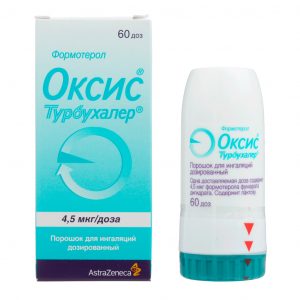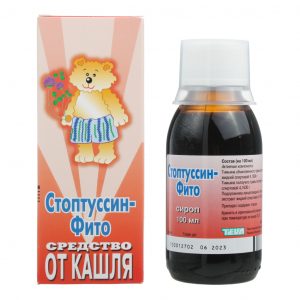Description
Latin name
Simbicort Turbuhaler
Release form
Powder for inhalation in the form of granules from white to almost white, mostly rounded.
Packaging
60-dose vial.
Pharmacological action
Symbicort Turbuhaler – a combined drug for the treatment of bronchial asthma. Contains formoterol and budesonide, which have different mechanisms of action and exhibit an additive effect with respect to reducing the frequency of exacerbations of bronchial asthma.
Budesonide – GCS, after inhalation, has an anti-inflammatory effect on the respiratory tract, which lasts several hours and is dose-dependent. Reduces the severity of symptoms and the frequency of exacerbations of bronchial asthma. With the appointment of budesonide in the form of inhalation, a lower incidence of serious undesirable effects is noted than with systemic corticosteroids. Reduces the severity of edema of the bronchial mucosa, mucus production, sputum formation and respiratory tract hyperresponsiveness. The exact mechanism of the anti-inflammatory action of GCS is not known.
Formoterol is a selective 2-adrenergic receptor agonist. Causes relaxation of the smooth muscles of the bronchi in patients with reversible airway obstruction. The bronchodilator effect is dose-dependent, occurs within 1-3 minutes after inhalation and persists for at least 12 hours after taking a single dose.
In clinical studies, it was found that with the combined use of formoterol and budesonide, the severity of symptoms of bronchial asthma decreases, lung function improves, and the frequency of exacerbations of the disease decreases. The effect of Symbicort Turbuhaler on lung function corresponds to the action of a combination of the single drugs budesonide and formoterol and exceeds the effect of one budesonide. There was no decrease in anti-asthma action over time. The drug has good tolerance. The drug has good tolerance. While taking Symbicort Turbuhaler as a maintenance therapy for 12 weeks in children aged 6 to 11 years (two inhalations of 80 / 4.5 μg / inhalation 2 times / day), lung function improved and drug tolerance was noted, compared with appropriate dose of budesonide Turbuhaler.
In patients with severe chronic obstructive pulmonary disease (initial FEV1 – 36%) with the use of Symbicort Turbuhaler, there was a significant decrease in the frequency of exacerbations of the disease compared with patients who received only formoterol or placebo as the treatment (average exacerbation rate was 1.4 compared to 1.8- 1.9 in the placebo / formoterol group). There were no differences between taking Symbicort and formoterol with respect to FEV1 values.
Indications
Bronchial asthma (not adequately controlled with short-acting inhaled corticosteroids and beta2-adrenergic agonists as demanding therapy, or adequately controlled with long-acting inhaled corticosteroids and long-acting 2-adrenergic agonists) – as maintenance therapy and for relieving seizures.
Symptomatic therapy in patients with severe chronic obstructive pulmonary disease (FEV
Contraindications
Children under 6 years of age hypersensitivity to budesonide, formoterol or inhaled lactose.
Pregnancy and lactation
There are no clinical data on the use of Symbicort Turbuhaler or the combined use of formoterol and budesonide in pregnancy.
During pregnancy, Symbicort Turbuhaler should be prescribed only in cases where the expected benefits of therapy to the mother outweigh the potential risk to the fetus.
Budesonide should be used at the lowest effective dose necessary to maintain adequate control of asthma symptoms.
It is not known whether formoterol and budesonide with breast milk are excreted in humans. Symbicort Turbuhaler can be prescribed to nursing women if the expected benefit of the therapy for the mother outweighs the potential risk to the baby.
Composition
1 dose contains:
Active ingredients:
budesonide 160 mcg,
frmoterol fumarate dihydrate 4.5 mcg
Excipient:
lactose monohydrate.
Dosage and Administration
Inhalation.
Dose selection is individual and depends on the severity of the disease. Adults and children over 12 years of age: when using an inhalation powder containing budesonide and formoterol in a ratio of 80 μg / 4.5 μg / dose – 1-2 inhalations 2 times a day 160 μg / 4.5 μg / dose – 1-2 inhalations 2 times a day.
After optimal control of the symptoms of bronchial asthma has been achieved with the administration of the drug 2 times a day, the dose may be reduced to the least effective.
Side effects
From the side of the central nervous system: headache, psychomotor agitation, anxiety, nausea, dizziness, sleep disturbances, depression, behavior disorders (mainly in children), taste disturbances.
From the cardiovascular system: palpitations tachycardia atrial fibrillation, supraventricular tachycardia, extrasystole angina pectoris, fluctuations in blood pressure.
From the musculoskeletal system: tremor muscle cramps.
From the respiratory system: candidiasis of the mucous membrane of the oral cavity and pharynx, mild irritation in the throat, cough, hoarseness bronchospasm.
Dermatological reactions: bruising exanthema, pruritus, dermatitis.
Allergic reactions: urticaria, angioedema, anaphylactic reactions.
Metabolic disorders: hypokalemia, hyperglycemia, symptoms of systemic effects of corticosteroids (including adrenal hypofunction).
Drug Interaction
Taking 200 mg of ketoconazole once daily increases the plasma concentration of orally administered budesonide at a dose of 3 mg by an average of 6 times. When ketoconazole is administered 12 h after budesonide administration, the concentration of the latterone in the plasma increases 3 times.
There is no information on such interaction with inhaled budesonide, but a significant increase in plasma concentrations should be expected (if such a combination cannot be ruled out, the interval between the administration of ketoconazole and budesonide should maximize or decrease budesonide doses).
Dr. CYP3A4 inhibitors are also likely to significantly increase plasma budesonide concentrations. Beta-adrenergic receptor blockers (including in the form of eye drops) attenuate formoterol. Quinidine, disopyramide, procainamide, phenothiazines, antihistamine drugs (terfenadine), MAO inhibitors and tricyclic antidepressants increase the risk of QT lengthening and ventricular arrhythmias. Dopamine, levothyroxine sodium, oxytocin and ethanol reduce the tolerability of beta2-adenostimulators by the myocardium. MAO inhibitors, furazolidone and procarbazine increase the risk of increased blood pressure.
Halogen-containing hydrocarbon drugs for general anesthesia increase the risk of arrhythmias. Dr. beta-stimulants increase the severity of formoterol side effects. Xanthine derivatives, ISS, some diuretics, cardiac glycosides increase the risk of hypokalemia.
Overdose
Symptoms: no acute clinically relevant symptoms are expected with acute budesonide overdose, even at high doses. In chronic administration of budesonide in excessive doses, the systemic action of ACS, such as hypercorticism and suppression of adrenal function, may manifest.
At overdose of formoterol – tremor, headache, palpitations in some cases the development of tachycardia, hyperglycemia, hypokalemia, prolongation of QTc interval, arrhythmia, nausea, vomiting was reported.
With acute bronchial obstruction formoterol 90 mg for 3 h was safe.
Treatment: Supportive and symptomatic treatment is indicated.
In case of withdrawal of Symbicort Turbuchaler due to overdosage of formoterol, the incoming and the composition of the combined drug, the appointment of an appropriate ACS should be considered.
Storage conditions
At a temperature not exceeding 30 ° C.
Expiration
2 Year
Deystvuyuschee substances
budesonide, formoterol
Dosage form
Dosage form
powder for inhalation
AstraZeneca, United Kingdom




